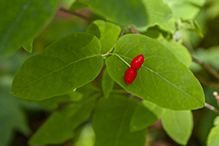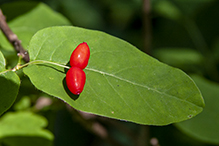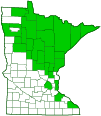American fly honeysuckle
(Lonicera canadensis)
Conservation • Wetland • Description • Habitat • Ecology • Use • Distribution • Taxonomy
Description |
||
American fly honeysuckle is a straggly deciduous shrub. It occurs in northern United States from Maine to Minnesota, south to New Jersey and Indiana and along the Appalachian Mountains to North Carolina, and in Canada from Nova Scotia to southern Manitoba. In Minnesota it is very common in the northeastern third of the state, where it is at the western extent of its range. It is found in moist to moderately dry upland coniferous and deciduous woodlands, sometimes in lowland forests and swamps. It grows in sandy or loamy soil under full to partial shade. American fly honeysuckle is a perennial shrub that rises on one or more stems from a shallow root system. The stems are slender and branched. They can be up to ¾″ in diameter at the base and 24″ to 80″ in height, but are usually no more than 40″ tall. They may be erect or sprawl along the ground. When sprawling, they produce roots where the stem contacts the ground. The stem detaches at that point, creating a new plant. The branches are erect to horizontal (spreading). First year stems and branchlets are round in cross section, hairless, greenish to purplish, and smooth to the touch. Second year stems are brown to reddish-gray. The mass of spongy cells in the center of the stem (pith), best seen when the stem is sliced at an angle, is solid and white. The bark is thin, fibrous, and brown or reddish-gray. It peels in long strips that hang on the stem. When a leaf drops away, the scar that remains (leaf scar) is small and inconspicuous. Winter buds are small and pointed. The leaves are opposite, 1 3⁄16″ to 3½″ (3 to 9 cm) long, and 1″ to 2″ (2.5 to 5.0 cm) wide. They are on ⅛″ to ¼″ (6 to 6 mm) long stalks (petioles). The petioles have a fringe of hairs. The leaf blades are lance egg-shaped, widest near the base, to almost elliptic, widest just below the middle. They may be rounded, slightly heart-shaped, or broadly-wedge-shaped at the base, and broadly or narrowly angled at the tip. The upper surface is dark green and hairless. The lower surface is lighter green and hairless or sparsely hairy. The margins are untoothed and have a fringe of hairs (cilia). The cilia may be hard to see, and may wear away as the leaf ages. The flowers appear in early May to early mid-June. The inflorescence is a single pair of flowers rising from the leaf axils near the end of the current year’s stems and branches. Each flower pair is on a hairless, ⅜″ to ¾″ long (1 to 2 cm) long stalk (peduncle). Each individual flower is stalkless. The flowers are ½″ to ⅞″ (12 to 22 mm) long. There are 5 outer floral leaves (sepals), 5 petals, 5 stamens, and 1 style. The sepals are green and very short, less than 1⁄32″ (0.2 to 0.6 mm) long. They are fused at the base then separated into 5 lobes. The petals are pale yellow and sometimes tinged with purple. They are fused at the base and for at least half their length into a narrow floral tube, then separated into five lobes. The stamens have pale yellow anthers and protrude a little beyond the floral tube. The style has a cap-like tip (stigma) and protrudes well beyond the floral tube. The aggregate of fruit (infructescence) is a pair of soft, bright red, egg-shaped, ¼″ to 7⁄16″ (6 to 11 mm) long berries. The berries touch at the wide base and spread nearly horizontally. They mature in late early mid-June to early August. and remain on the plant until picked off by birds or mammals. |
||
Height |
||
24″ to 40″ |
||
Flower Color |
||
Pale yellow |
||
Similar Species |
||
| Mountain fly honeysuckle (Lonicera villosa) leaf blades are widest at or beyond the middle. The upper leaf surface is hairy. The flowers are much smaller, no more than ⅜″ long. The infructescence is a single bluish-black berry. | ||
Habitat |
||
Moist to moderately dry. Upland coniferous and deciduous woodlands, sometimes in lowland forests and swamps. Full to partial shade. Sandy or loamy soil. |
||
Ecology |
||
Flowering |
||
Early May to early mid-June |
||
Pests and Diseases |
||
|
||
Use |
||
|
||
Distribution |
||||
|
Sources |
|||
| 2/10/2023 | ||||
Nativity |
||||
Native |
||||
Occurrence |
||||
Very common in northeast Minnesota |
||||
Taxonomy |
|||
| Kingdom | Plantae (green algae and land plants) | ||
| Subkingdom | Viridiplantae (green plants) | ||
| Infrakingdom | Streptophyta (land plants and green algae) | ||
| Superdivision | Embryophyta (land plants) | ||
| Division | Tracheophyta (vascular plants) | ||
| Subdivision | Spermatophytina (seed plants) | ||
| Class | Magnoliopsida (flowering plants) | ||
| Subclass | Caryophyllidae | ||
| Superorder | Asteranae | ||
Order |
Dipsacales (honeysuckles, moschatels, and allies) | ||
Family |
Caprifoliaceae (honeysuckle) | ||
| Subfamily | Caprifolioideae | ||
Genus |
Lonicera (honeysuckles) | ||
| Subgenus | Lonicera | ||
Subordinate Taxa |
|||
|
|||
Synonyms |
|||
Xylosteon ciliatum |
|||
Common Names |
|||
American fly honeysuckle American fly-honeysuckle Canadian fly honeysuckle fly honeysuckle |
|||
Glossary
Elliptic
Narrowly oval, broadest at the middle, narrower at both ends, with the ends being equal.
Peduncle
In angiosperms, the stalk of a single flower or a flower cluster; in club mosses, the stalk of a strobilus or a group of strobili.
Petiole
On plants: The stalk of a leaf blade or a compound leaf that attaches it to the stem. On ants and wasps: The constricted first one or two segments of the rear part of the body.
Pith
The spongy cells in the center of the stem.
Sepal
An outer floral leaf, usually green but sometimes colored, at the base of a flower.
Spreading
Extending nearly horizontal.
Visitor Photos |
|||||
Share your photo of this plant. |
|||||
| This button not working for you? Simply email us at info@MinnesotaSeasons.com. Attach one or more photos and, if you like, a caption. |
|||||
|
|||||
MinnesotaSeasons.com Photos |
|||||
Leaves |
|||||
 |
|||||
Infructescence |
|||||
 |
|||||

Slideshows |
||
| American Fly Honeysuckle (Lonicera canadensis) Andree Reno Sanborn |
||

|
||
About
Native, non-invasive |
||

Visitor Videos |
|||
Share your video of this plant. |
|||
| This button not working for you? Simply email us at info@MinnesotaSeasons.com. Attach a video, a YouTube link, or a cloud storage link. |
|||
Other Videos |
|||

Visitor Sightings |
|||||
Report a sighting of this plant. |
|||||
| This button not working for you? Simply email us at info@MinnesotaSeasons.com. Be sure to include a location. |
|||||
| Dan Hill 6/4/2023 |
Location: Franklin N.H. |
||||
MinnesotaSeasons.com Sightings |
|||||

Created: 2/4/2020
Last Updated:
